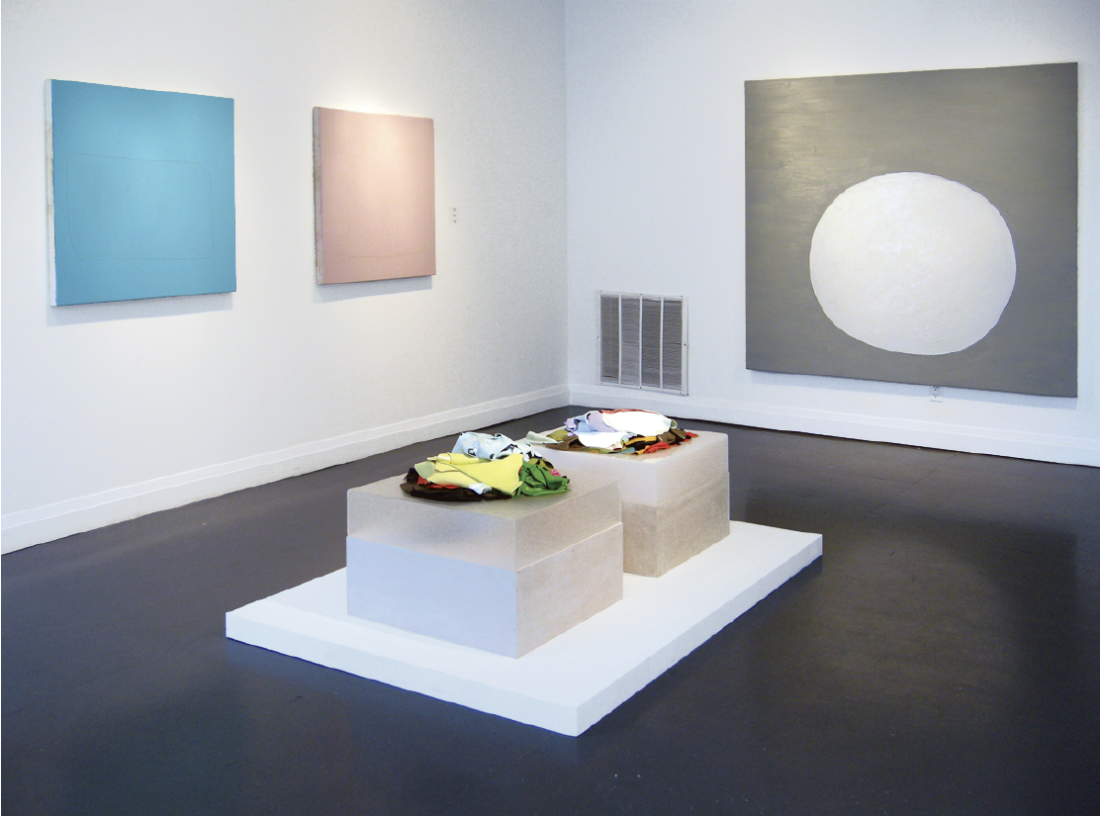Jeanie Riddle
I suspect that any punning replay of Winston Churchill’s famous description of Russian behaviour as “a Riddle, wrapped in a mystery, inside an enigma” could no longer be anything but an old, unamusing joke to Montreal-based artist Jeanie Riddle, whose exhibition, “To This Place,” was at Toronto’s Angell Gallery from September 29 until October 29. She is well known as the director of the Montreal gallery Parisian Laundry, but perhaps less so as a painter and maker of installation works—at least outside of Montreal; Riddle’s small but forceful exhibition at Angell should serve as something of a corrective. In her private practice as an artist, she is assuredly the maker, if not precisely of mysteries, then certainly of enigmas. Especially with her sculpture installations—of which there were two in the Angell exhibition. Both of these small works were simultaneously titled and untitled, which is to say they were both labelled Untitled (California). It is initially unclear what makes them redolent of California. Their hot, surf-side hues, maybe, or the fact that one of them looks, at first glance, to be a stack of deflated beach balls. The most probable explanation for their “California” nomenclature, however, is that the two works now serve as souvenirs of the environmentally large, shiny white, open, fluorescently illuminated, catafalque-like box Riddle exhibited at Montreal’s Centre d’exposition Circa in 2009 that held, within its floating, rectangular whiteness, a small assortment of pedestal-like boxes and two chromatically intense stacks of shiny fabric swatches, or deflated beach balls made of latex, with house paint.

Jeanie Riddle, installation view of “To This Place” at Angell Gallery, Toronto, 2011.
As with her paintings, Riddle locates these sculptures, with satisfying precariousness, on the pivotal edge between the formalist past and the Formless (informe) recent past. Riddle’s shiny stacks are accumulations, speaking wittily and irreverently to certain “amassing” works of the 1960s—to Lynda Benglis’s poured latex pieces (for example, Benglis’s Night Sherbet A from 1968 is a dead ringer for one of Riddle’s latex piles, if you take away her birchwood base) and certain pieces by Jessica Stockholder.
Though Riddle’s stacks sometimes look like plasticized heaps of discarded clothing, their fast, glazed surfaces that offer only a slippery, skittering site for the eye’s glancing blow preclude the meditative time required to turn them into discarded stacks of clothing in the poignant, Christian Boltanski sense. So Riddle’s bright, hectic, intensely hued piles of indestructible industrial-strength leftovers appear to work as faux reminiscences. It is almost with a certain callousness that they can be seen to function as a species of morphological emetic that induces the evacuation of all sentimentalizing. What is odd about the sculptures, though, is how, even when you dismantle and give up the “stacked clothes” program as unworkable, these amorphous piles still speak—in an almost demonic, sub-vocalized whisper—of their irrepressible relatedness to our bodily histories and conditions.
Riddle’s paintings, so initially placid, calm, whole and decorator-monadic, appear to take their place somewhere on the trajectory of the monochrome’s history. And, really, the inclination is rather to stay way back from them, where the livin’ is easy, and simply enjoy their apparently guileless formats that consist either of presentations of compositionally reduced two-nesses, like Hero with a picture-filling charcoal disc on a grey ground, for example, or their meditative one-nesses represented by a clutch of smaller, 36” x 36” squares of a single colour like All of It, a delicate dove grey, or Around (Us), a soft unpasturized cream.
But all this easy reverie is increasingly compromised and quite forcibly re-jigged when you get closer and pay attention to the degree to which, in the disc paintings, the discs aren’t really discs at all. Rather, they turn out to be wobbly, emphatically non-geometric, lake-like concentrations of colour that got that way by being very heavily brushed and isolated by a quite strident brushing in the ground of the paintings, a surround that keeps the pseudo discs in place or, in fact, creates them in the first place. Looked at close up, these seemingly remote, cool, unengaged surfaces of Riddle’s are, in fact, alive with heavy oil paint—a vectorial paint that gives direction and speed, and orders the painting surfaces around.
Riddle’s square, and occasionally rectangular, paintings have no para-discs to marshal and isolate; and so, settling into being indivisible lozenges of colour, they can then be activated not by acting but by being acted upon as Riddle cuts into their heavily pigmented surfaces.
Her score lines are few but powerful, the ghost marks of depleted still-life givens (table edges or widow ledges maybe). Or perhaps this residual representation is so residual it isn’t there at all. In which case, her gorgeous paintings are first whole and perfect and then brought to earth by the world’s oldest expressive gesture: the slash, the cut, the slice, the defacement, the entropic falling to earth. ❚
“To This Place” was exhibited Angell Gallery, Toronto, from September 29 to October 29, 2011.
Gary Michael Dault is a critic, poet and painter who lives near Toronto.

